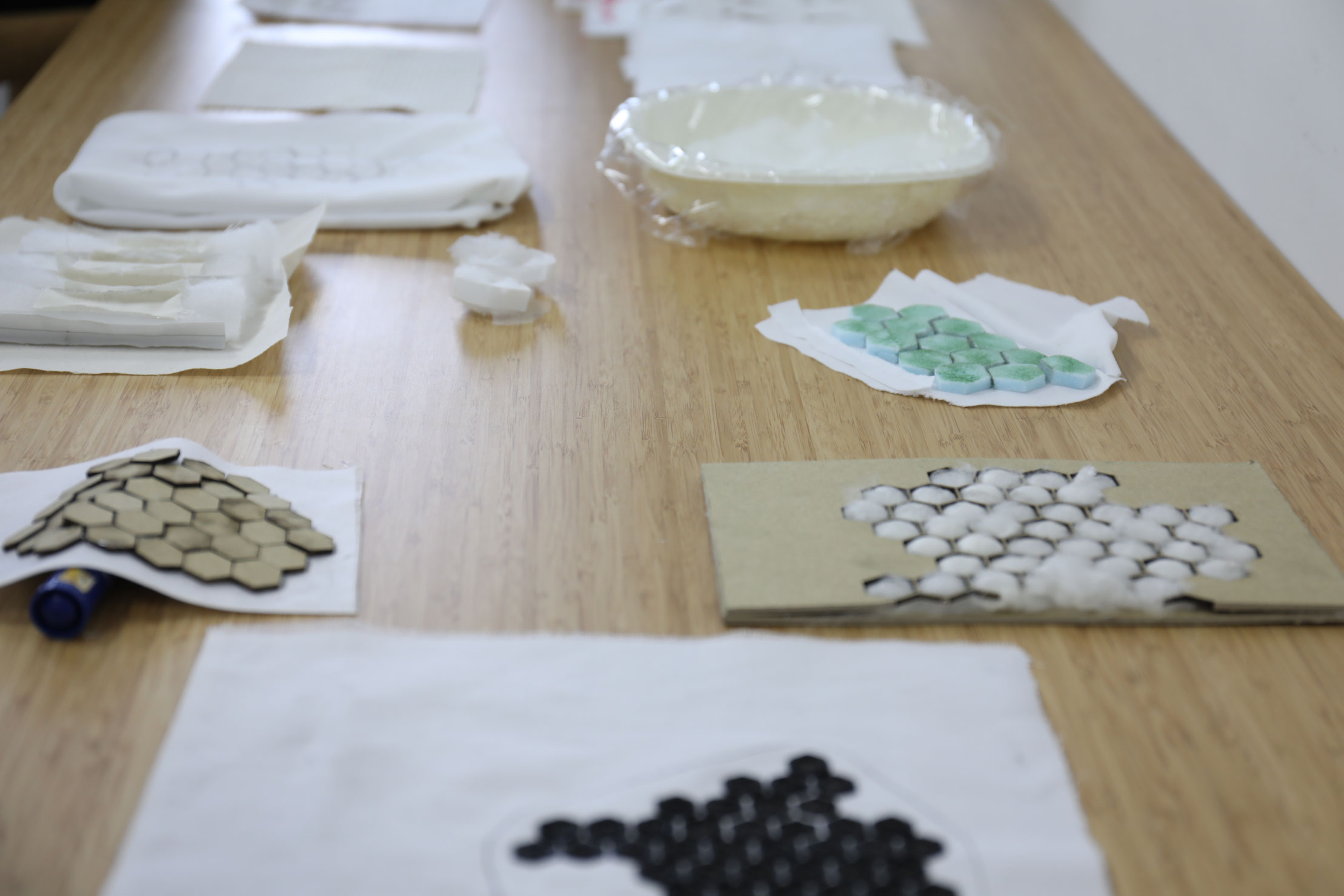
Text: 野村涼平
サマースクールに参加した理由
2016年、KYOTO Design Lab(以下D-lab)と英国王立芸術学院(以下RCA)が共同開催したデザイン・ワークショップ「インテリジェント・テキスタイル」に参加して以来、私はテキスタイルデザインに注目してきた。建築デザインを学ぶ身からしても、空間構成要素としてあまり注目されてこなかったテキスタイルについて、その可能性を探求することに大きな可能性を感じたからだ。今回のサマースクールもデザインアカデミー・アイントホーフェン(以下DAE)とRCAから来日した、テキスタイルデザインをはじめ、デザインリサーチ、プロダクトデザインなどを専攻する学生たちと協働できるまたとない機会であった。
現場から学んだ丹後編
テキスタイルとは一般に織物や布地を指すが、それ自体私たちの生活の中で極めて身近な存在でありながら、あるいはそれ故に、未知と既知の可能性に満ち溢れたデザインの対象である。そのことを身をもって経験することができたのは、サマースクール前半で訪れた丹後の地であった。私たちは丹後の伝統産業である縮緬(ちりめん)とその高度な技術を現場で見学した。後継者不足や産業の縮小に直面しながらも、闊達に新しい技術や製品の開発に取り組む生産者との対話からは、驚くような発見とインスピレーションを得ることができた。
美しい貝殻や木の薄片を緯糸(よこいと)として織り込む技法、一定間隔で経糸(たていと)に絡みを加え布に透かしを与える技法など、試行錯誤して生み出してきた技術を実際に目にし、私のテキスタイルへの認識が分解・再構築されていくことが実感できた。それは、テキスタイルとはすなわち、経糸と緯糸の立体構造物であり、糸の素材としての物性やその撚り方、組織の構造等の組み合わせによって極めて多様な性質や表層を実現する可能性を持っているということである。
京丹後編は、私たちが見学に訪れたテキスタイル生産者の方々とのワークショップをおこない幕を閉じた。それぞれが生産するテキスタイルのサンプルをご持参いただき、そのテキスタイルを用いた新たなシナリオを、私たちと共に構想した。
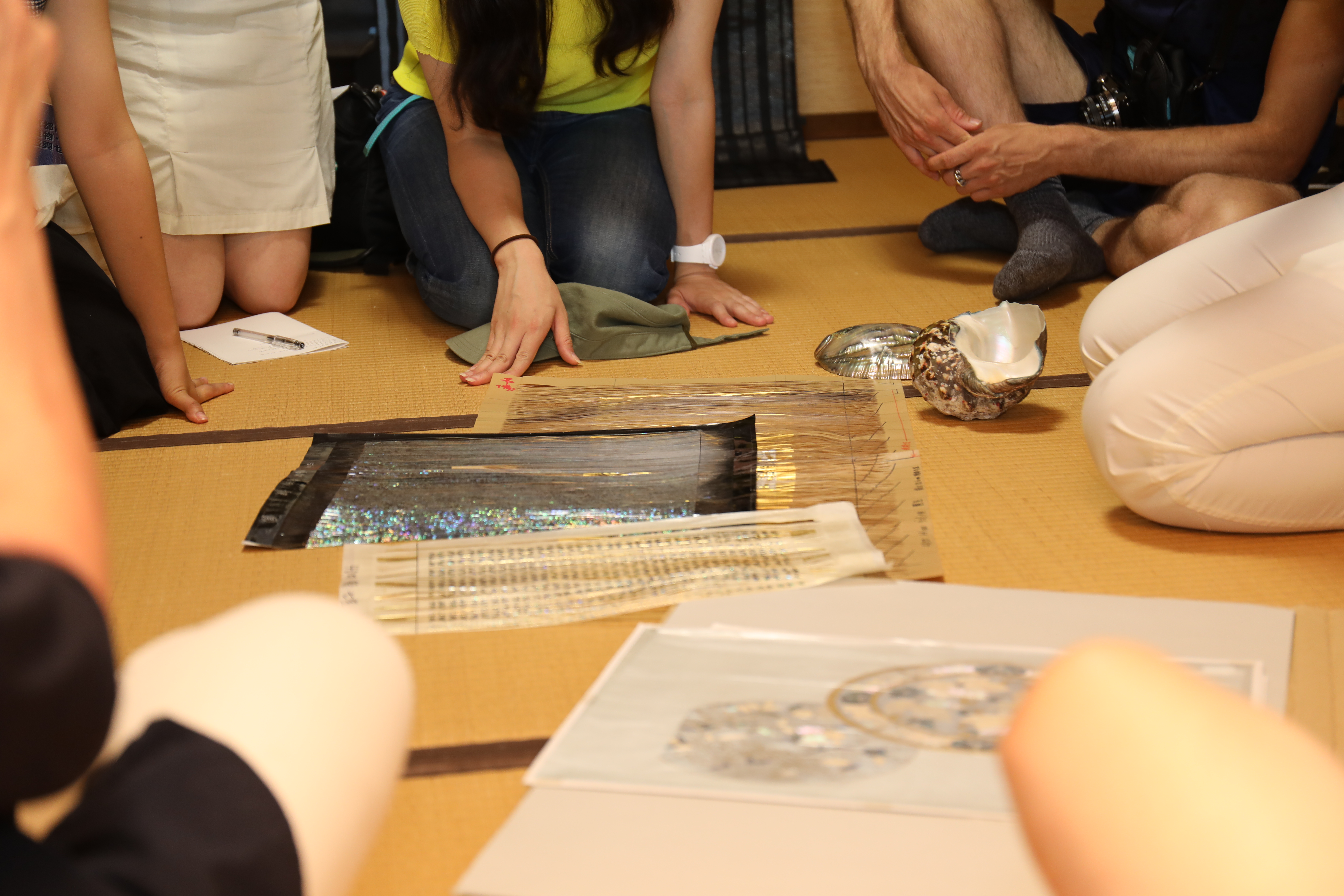
京丹後での見学の様子
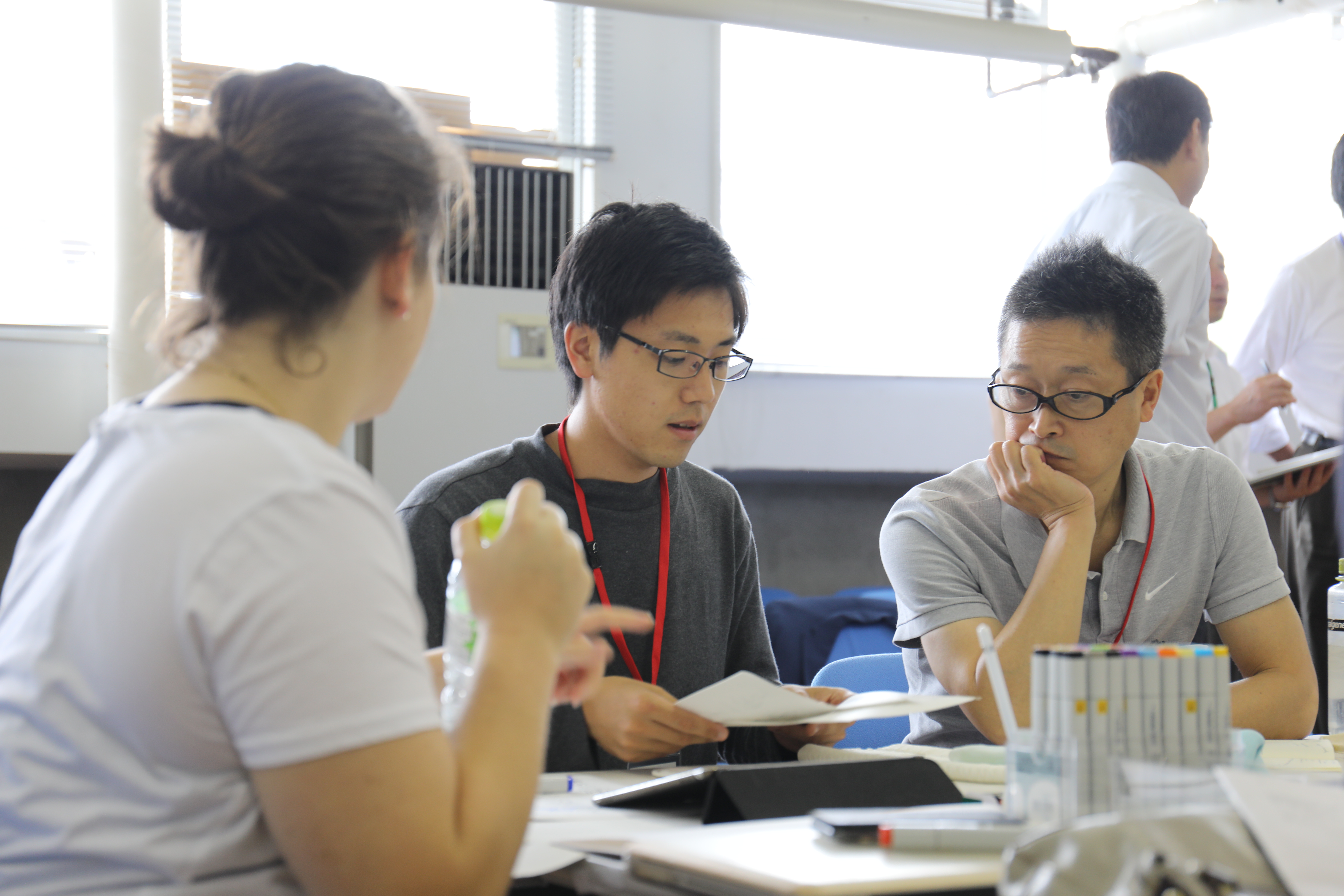
京丹後編最終日のワークショップ。実際に生産するテキスタイルを題材にアイデアを考える機会は、生産者自身にとってもはじめての経験となった
柔軟なシステムとしてのテキスタイルデザイン
サマースクールKIT編の初日、京丹後編でフォーカスした縮緬や絹織物から再び視野を押し広げるように、全く切り口の異なるレクチャーがおこなわれた。デュポン社の合成繊維の歴史と最新の製品、KITのバイオベースマテリアル学専攻でおこなわれている竹から繊維を作りだす研究、さらには日本古来の柿渋染めの技法などの多様な染織技術など、テキスタイルの様々な側面について触れる機会であった。様々な素材や組織、革新的なものと伝統的なもの、これらの多角的で横断的なインプットに私たち参加者は集中して聞き入っていた。現役の生産者のみならず、研究者や企業の方々からの知見をも得られるのはこのサマースクールの大きな特徴であろう。
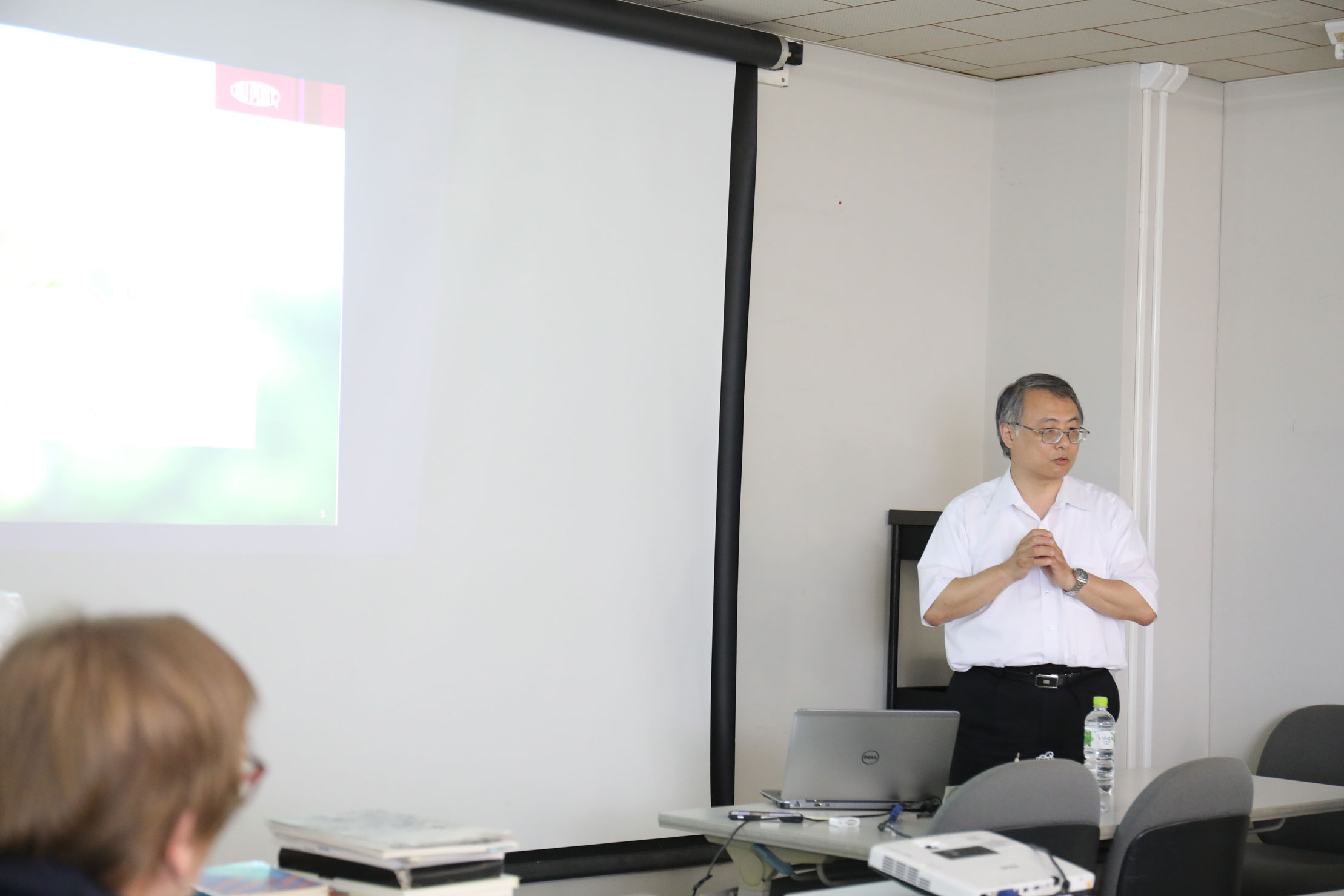
デュポン・スペシャルティ・プロダクツ株式会社の賀来氏によるレクチャーの様子
2日目、サマースクールのファシリテーターを務めたDAEのMichelleとRCAのMarionのリードのもと、テキスタイルデザインの可能性を開拓する即日のワークショップがおこなわれた。私はDAEのAdams、京都嵯峨美術大学の正木奈美、青山莉奈とチームを組み臨んだ。
「清潔さ」「自律的生活」「社会的繋がり」「極限環境」。これらはテキスタイルデザインを考えるうえでファシリテーターから提案されたキーワードの一例である。私たちのチームはこれらを着想点として新たなテキスタイルのアイデアを出し合った。そしてそれらのアイデアについて、テキスタイルデザイナーが中心となってその実現に必要な素材・組織・表層を考察する。そしてチーム全員でそのテキスタイルが持つ可能性をシナリオとして視覚化していった。
通常、テキスタイルとは原料を糸状に撚ったものが経緯に立体構築されたものであり、その糸の性質や組織の組み方によって、テキスタイルそれ自体にプロダクトや衣服などの素材としての特質や機能が与えられる。それを操作、構築するためには原料の糸そのもの、その撚り方や織り方、更にはプロダクトや衣服における素材としての振る舞いといった、極めて多様な事柄について多層的な思考を必要とする。そうしたなかで、私たちの中にはテキスタイルデザインとは、その原料から製品までを包括する一つの柔軟なシステムと捉え、多角的にそして構築的に考察を加えていくものであるという認識が生まれた。
ちなみに私たちのチームは「洗浄・殺菌・吸水をひと拭いで出来るテキスタイル」をポケットの内布に使った「Hygine pocket」というシナリオ、そして「内部の立体構造物で断熱、衝撃吸収機能を持ち得るテキスタイル」を用いた「Wearable Yogamat」などを提案した。2日目にして、既にアイデアの着想からその拡張、そして表現というプロセスを短期集中的に経験したことは、翌日以降の最終成果物製作に向けて非常に良い指針となったように思う。
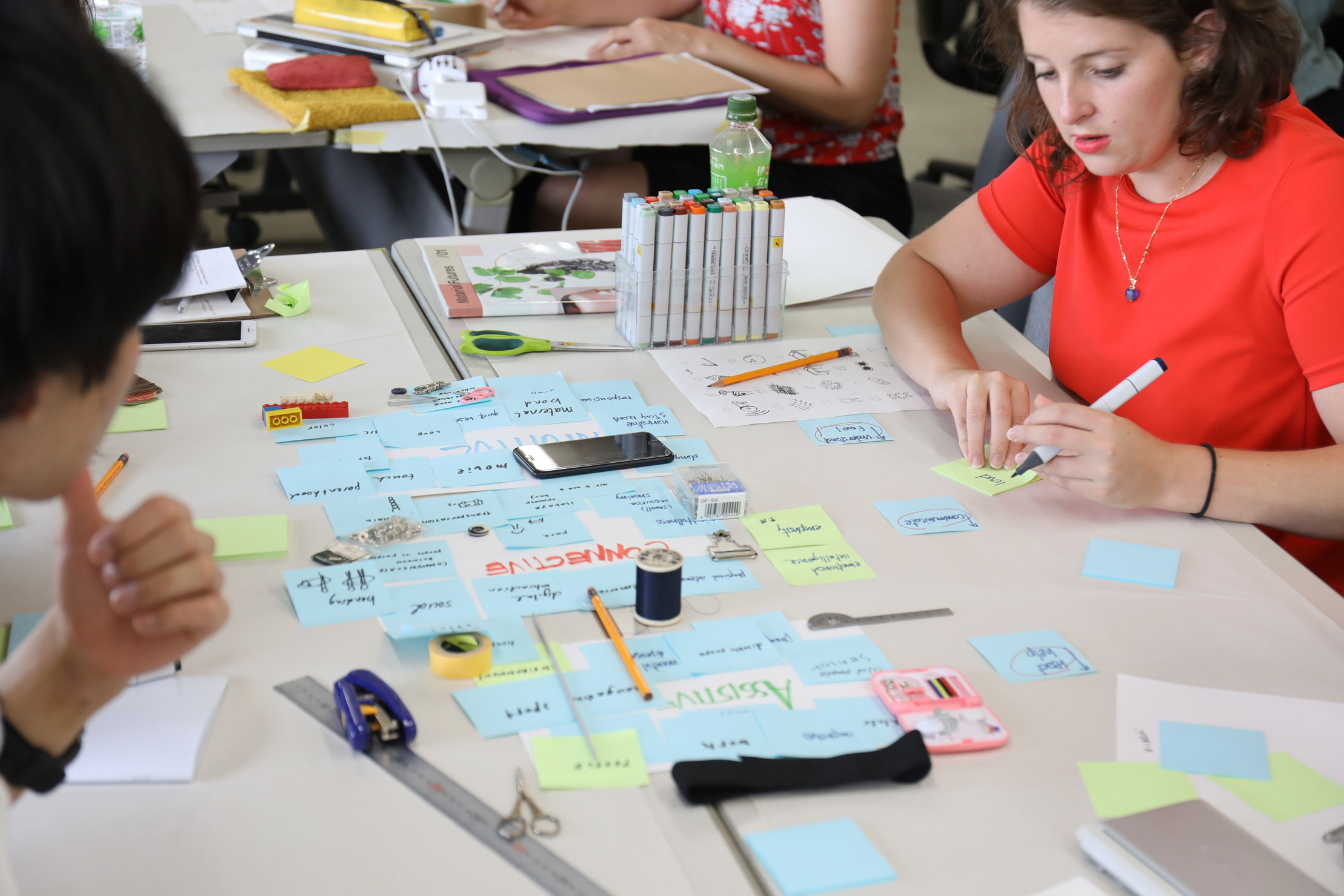
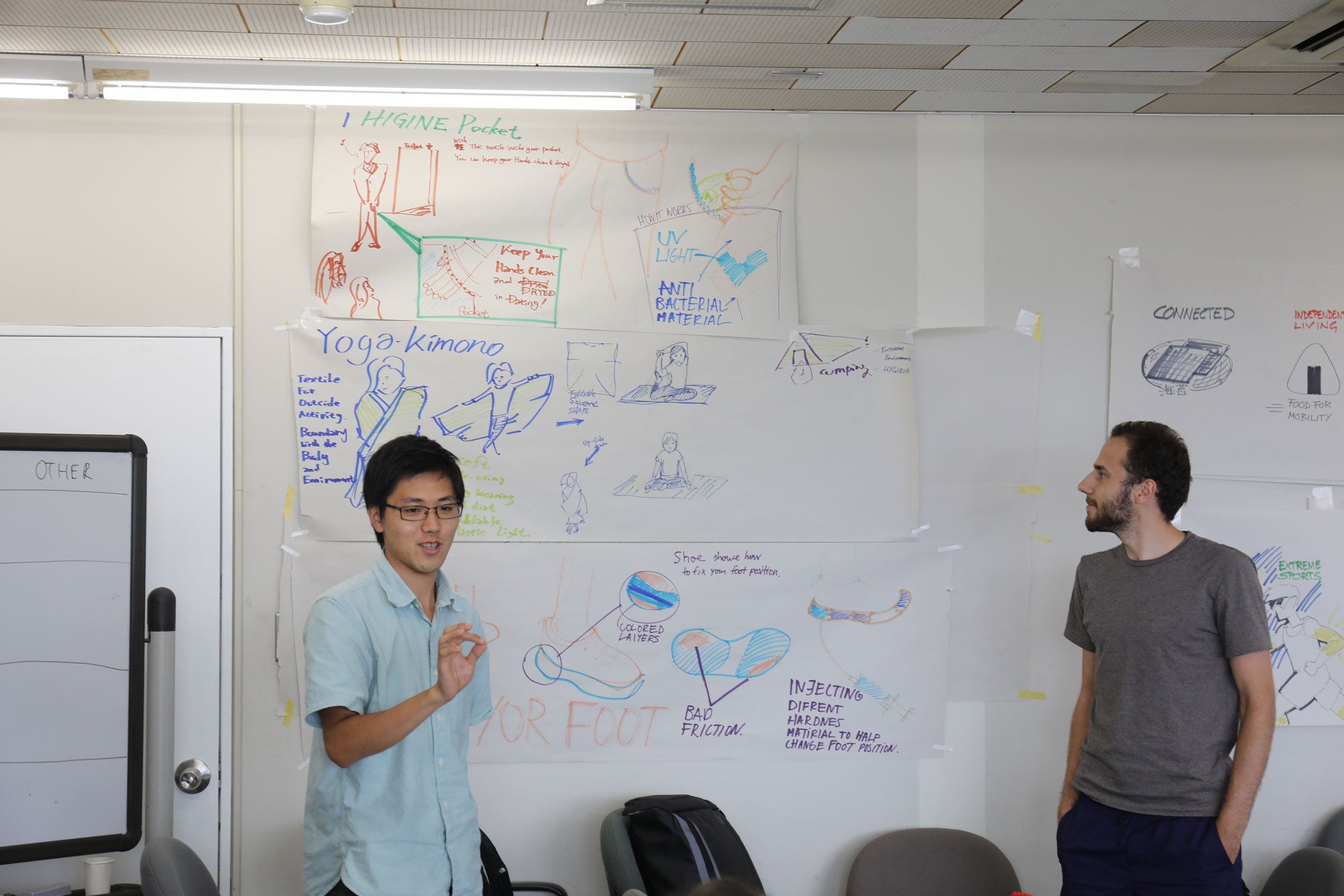
2日目の即日ワークショップの様子
そして午後にはRCAテキスタイル専攻長のAnne Toomey氏によるパブリックレクチャーが開催され、世界で日々開発されている先端的なテキスタイルデザインの広範な紹介がおこなわれた。資源やエネルギーを回収・再利用するテキスタイルや、新しい織機の概念を提示するデザインなどが取り上げられ、テキスタイルデザインの柔軟な可能性をさらに実感することとなった。そしてここでも指摘されたことは、テキスタイルデザインとは素材や製品そのものだけでなく、それらを構築するシステムとしてテキスタイルを考察するものであるということであった。
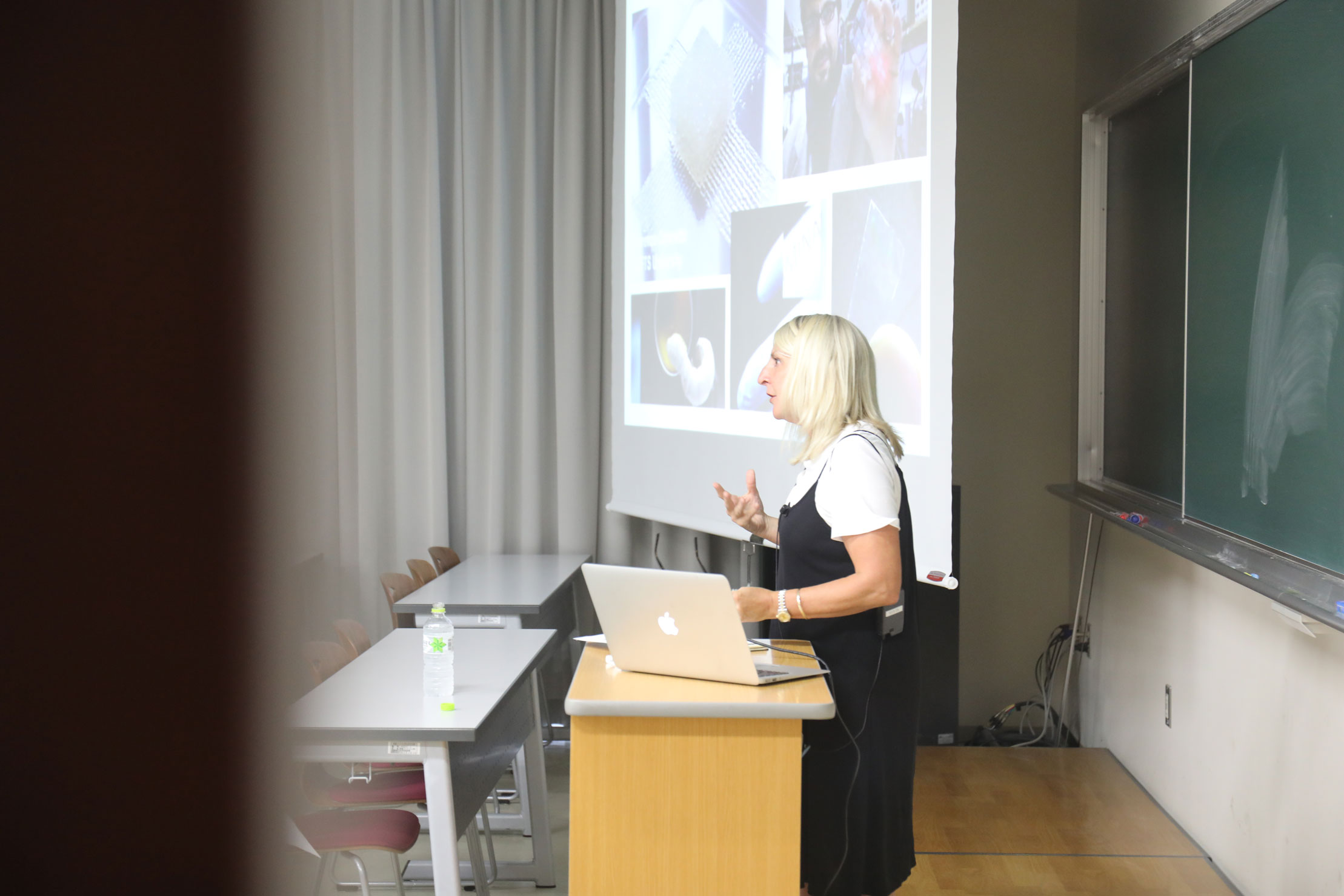
アン・トゥーミー氏のレクチャー「アドバンスド・テキスタイル——サーフェイス、構造、ソフトシステム」
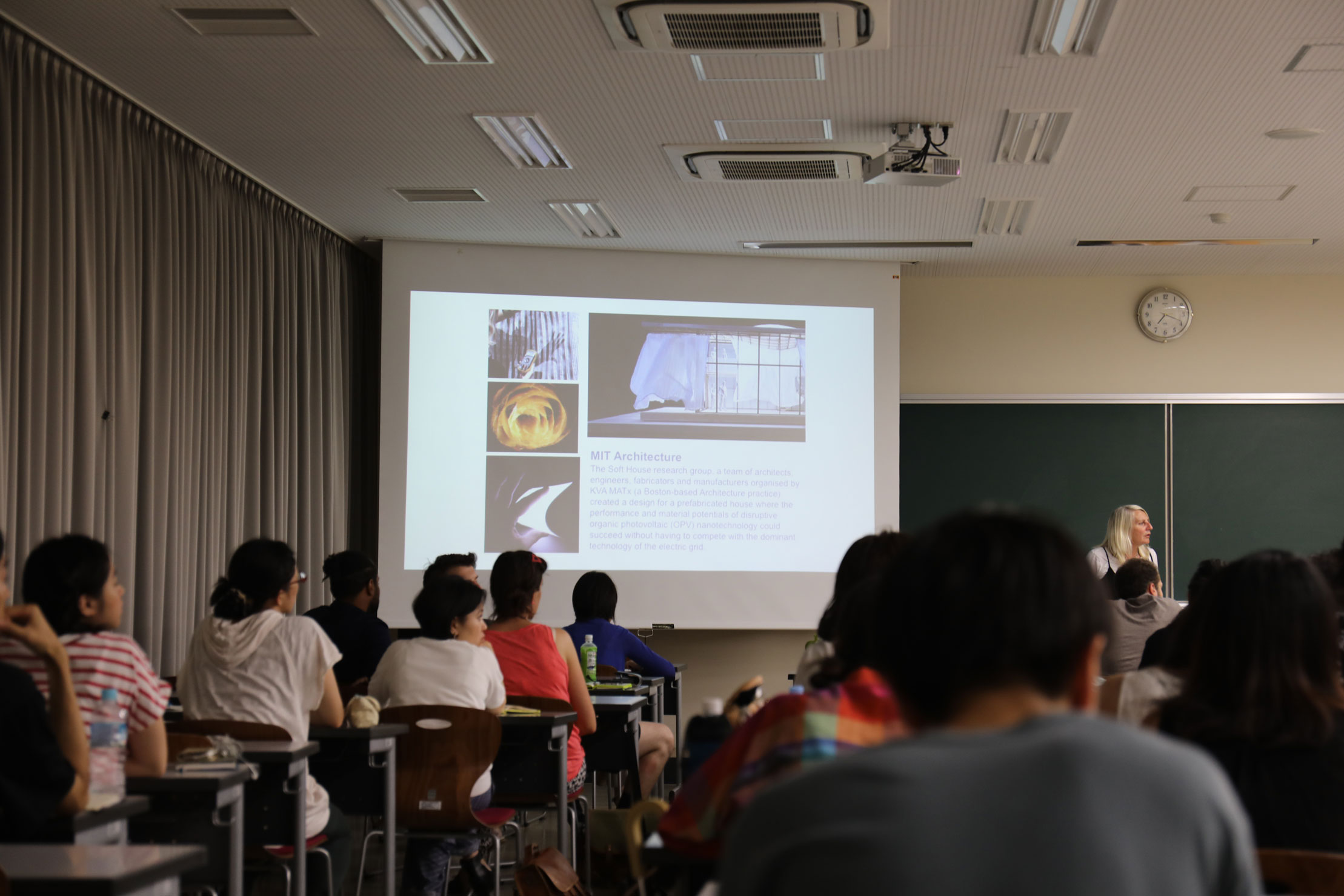
テキスタイルを用いた建築への応用についても話があった
サマースクールは毎日5時には終了するので、夜には参加者達と夕飯へと繰り出す。ラーメンや回転寿司など日本の定番な場所から、小さなバーや鴨川デルタといったローカルな場所などへ出向き色々な話題で交流を深めた。こうした場で交わされるくだけた会話からこそ、メンバー個々の興味や考え方などがよく見えてくる。

問いを立て、つくり、考える
3日目の午後からはいよいよ最終成果物に向けたアイデアづくりが始まった。4つのチームが再編成され、そのうちの2チームはより思索的な、つまり問題を提起するようなアプローチでデザインシナリオを構築することを目標に、残りの2チームはより「素材」としてのテキスタイルに注目しプロダクトを作り出すアプローチを取るよう求められた。私は素材特性に基づいてテキスタイルをデザインし、シナリオとして提示するアプローチに興味があったので前者にエントリーすることにした。そして先出のDAEデザイン専攻のAdamsとRCAテキスタイルデザイン専攻のFu、そして京都嵯峨美術大学のプロダクトデザイン専攻の宮崎大吾と染織学専攻の橋下和佳、京都工芸繊維大学院グラフィックデザイン専攻の岡田千春とチームを組んだ。
このサマースクールでは、アイデアやコンセプトを素早く生み出し、決定することが求められ、分野や言語が異なるチームの中でそれをおこなうことが、各メンバーにとって最も大きな挑戦であったと思う。私はチーム内で通訳をしていたこともあり、チーム全体と各々の進捗を俯瞰するマネジメントの役割も担うこととなり、ハードでありながら今後も新鮮で意義深い経験ができた。
私たちのチームがこの日に取り組んだことは、デザインクエスチョンを立て、どのようなテキスタイルについて考察するか、そのコンセプトを固めることであった。そのためにまずは、テキスタイルデザインのどういった部分に各メンバーが最も可能性を感じているかをシェアし、そのトピックを遠い未来の私たちの生活環境に投げかけてみて想像することから始めた。そこで考察されたのは、繊維原料の不足、都市部の個人占有空間の減少、細菌やその媒介となる昆虫の分布拡大などの創造的なシナリオであった。そして特に「人体の感覚能力とその認知の減退」はメンバーにとって興味深く感じられ集中的に議論を進めた。
そしてこの日のプレゼンテーションでは「外部環境的変化や特定の刺激に反応し、その表面の感触が変化するテキスタイル」というコンセプトを発表した。講師陣からはそのコンセプトはどのようなデザインクエスチョンに答え得るものなのかを明確化することや、この挑戦的なコンセプトの実現のため翌日以降たくさんの簡単なプロトタイプを作成することなどの助言が得られた。毎日の作業の終わりに講師やファシリテーターに向けてプレゼンテーションをおこないフィードバックやアドバイスを素早く得られることで、チーム全体の目標を明確化しながら、自由にアイデア作りを進めることができた。
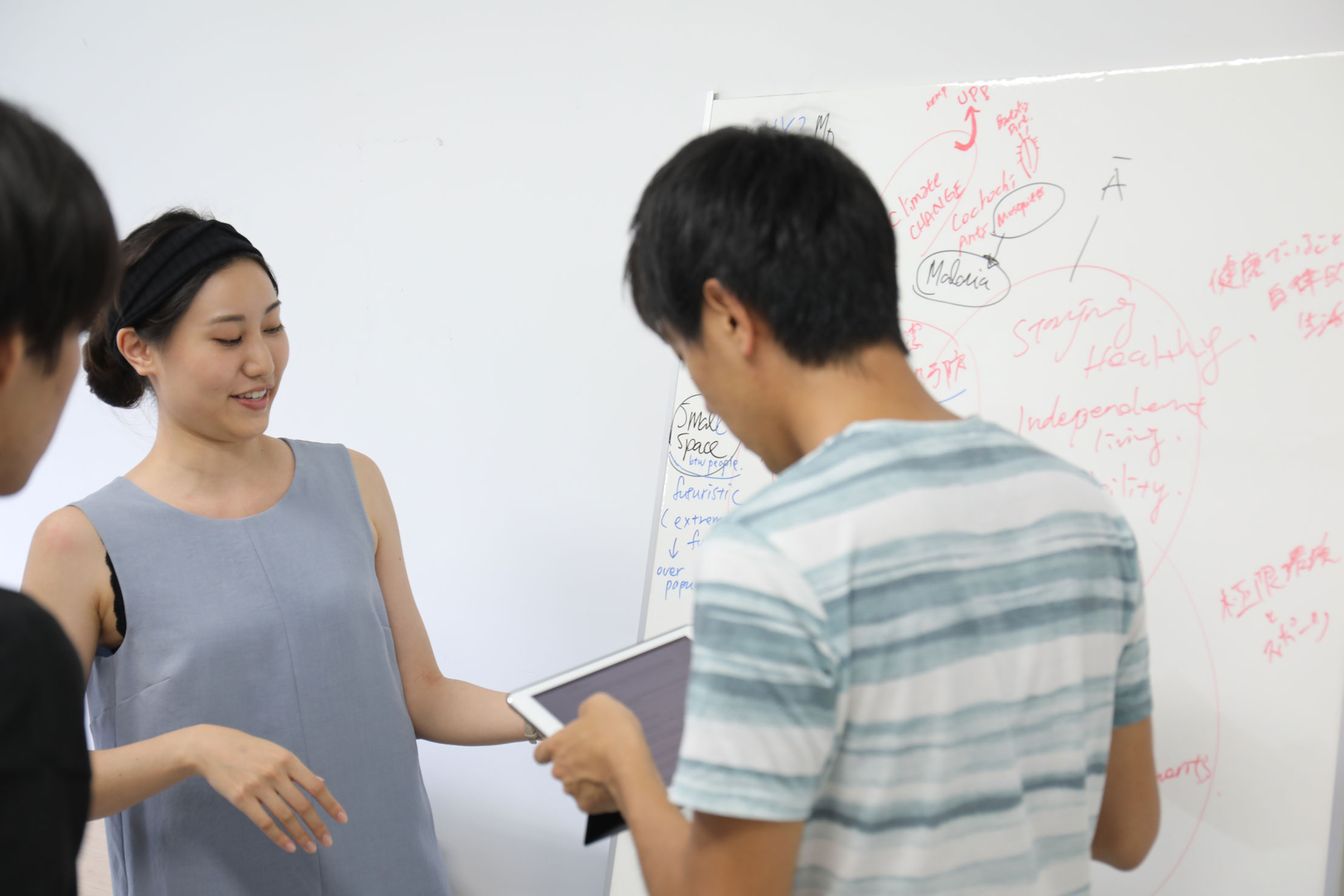
チームでのディスカッション
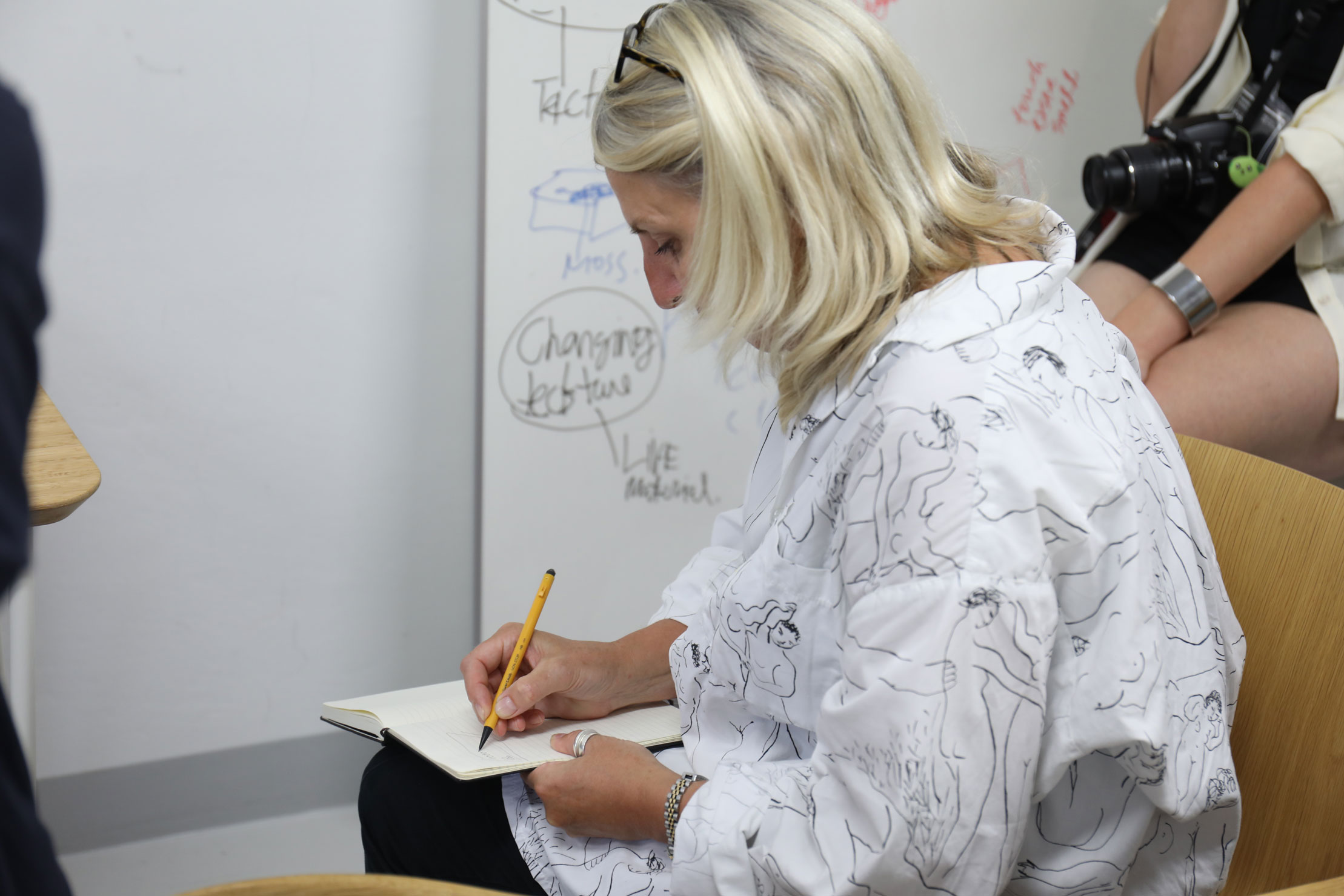
ときには講師から手描きのイラストによるフィードバックもあった
4日目は早くからそれぞれのコンセプトの実現に向けてプロトタイプ作りを各チーム始めた。私たちも「テキスタイルは、その感触の変化によって私たちの感覚を呼び覚ますか、そしてそれは何をもたらすか」という問いを立て、まずは紙や綿、水など手近な素材を使って「表面の感触が変化する構造物」をテーマにできるだけ多くのトライアルを重ねた。引っ張るとトゲが逆立つ2層構造の紙、強く押すと底面の突起に触れるスポンジなど、極めてシンプルなアイデアでも、それがかたちとなって現れてくると自分たちのコンセプトがより明確になり、可能性が拡張していくのが実感できる。
D-labの提供する作業環境はプロトタイプ作成に適した環境であり、様々なソフトウェアとマシンを駆使しながら、簡単なプロトタイプから最終成果物まで一貫した環境で製作に取り組むことができたことは大きな助けになった。
そしてこの時点で各々が着想した数々のアイデアを互いに表現し、体験し合いながらそのさらなる可能性について話し合った。これまでのインプットや議論に裏打ちされたアイデアやシナリオがたくさん作り出され、チームの雰囲気が高まる楽しい時間である。私たちは特に、引っ張りによって突起が逆立つ構造と、摩擦や圧縮でつぶれるハニカム構造を内包した構造に着目し、それらを実現するための素材、組織の検討やそれらのテキスタイルが適応されるシナリオの構築をおこなっていった。
この日の終わりにも講師陣を迎えてチーム内プレゼンテーションをおこなった。講師陣は私たちのチームが簡単な、しかし沢山のトライ&エラーを繰り返したことを特に評価した上で、参照すべきデザインの事例や私たちが考えていなかった素材などについてアドバイスをしてくれた。私たちは、翌日のプレゼンテーションまでに制作するシナリオとプロトタイプの詳細を話し合い、この日の作業を終えた。
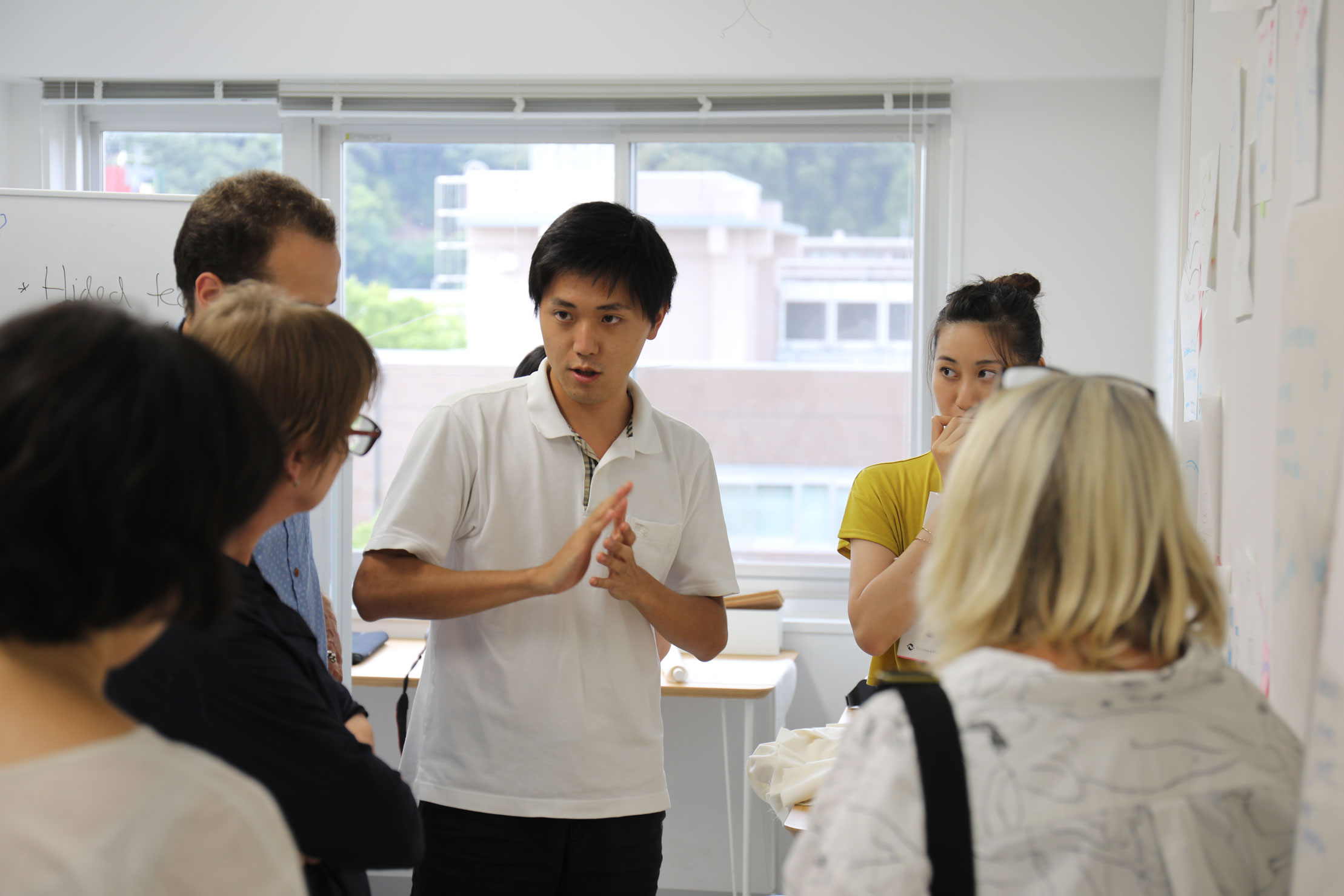

布が屈曲することで突起が現れるテキスタイルのプロトタイプ
テキスタイルは私たちの感触を呼び起こすことができるか、そしてそれはなにをもたらすか
最終日までに私たちが構築したデザインシナリオは「感触が変化するテキスタイルは、私たちが自身の誤った日常の姿勢や動作を認知し、矯正することの助けとなる」というものである。つまり私たちが誤った方法で習慣としている、例えば歩き方や姿勢の悪さなどによって生まれる特定の引っ張りや加重分布にテキスタイルの内部構造が反応し、その表面の感触を変化させることで私たちによりソフトなかたちで刺激を与え、そのことの認知、矯正に寄与するということである。
そのためのプロトタイプとして、靴とTシャツの製作を進めた。レーザー加工機でゴム板をハニカム構造の形状に切り出し、プレス機を用いて生地と接着した靴のアイデアでは、ユーザーが足の裏の局所的な部位に加重を載せたり、摩擦力をかける歩き方をした場合、その箇所のハニカム構造が崩れ足の裏に内部の突起が触れることでツボを押されるような感覚を覚える。屈折することで尖った部分が露出するパターンで裁断された柔らかい布を伸縮性のある布と合わせたテキスタイルを用いたTシャツのアイデアは、ユーザーの姿勢が曲がると尖った部分が背中に当たりソフトな不快感を与えることで姿勢の矯正を促す。これらの他にも長時間座ることを防ぐ椅子や、夏期の水分補給を促すTシャツの襟など、プロトタイプ作成まで至らなかったアイデアも複数あったが、限られた時間の中で最低限の機能性を備えたプロトタイプを作成した。
異なる専門知識やスキルを持った人々と協働する楽しさはこうした時に特に実感できる。各人が役割を積極的に見出し、互いに密にコミュニケーションをとりながら目標に向けて進んでいく。私はプロトタイプ製作に参加しながらプレゼンテーションの構成を進めた。
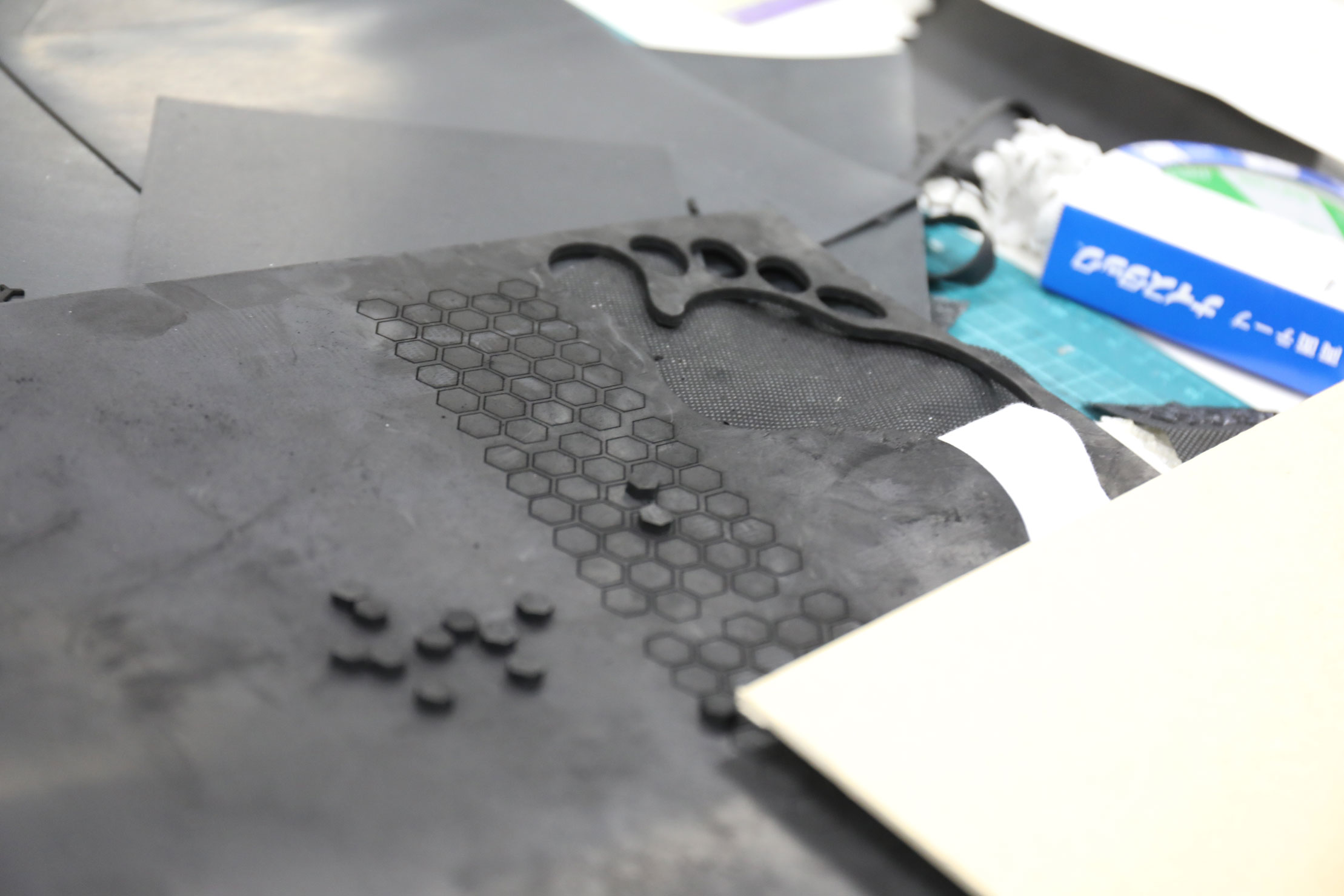
プロトタイプ制作の様子
最終プレゼンテーションでは、各チームそれぞれ個性的で鋭い思索に満ちたデザインが出揃った。複雑な内容でもヴィジュアルを多く用いて、初見の人でも文脈の理解しやすいプレゼンテーションばかりであった。最後にRCAのAnne Toomey教授とD-labのJulia Cassim教授によるフィードバックが各チームに対してあり、私たちのチームは、悪姿勢や間違った歩行フォームがもたらす深刻な健康問題に対して、極力シンプルな素材と方法でその解決を図るアイデアの、そのシンプルさゆえの拡張性と明快さが評価された。
会場には各チームのプロトタイプが展示され、プレゼンテーションの後には展示場所に来場者が赴き、会場のあちこちで多角的な議論が起こっていた。私たちのテーブルにも、来場者の学生や講師としてレクチャーしてくれた京都の金飾職人の方などが質問や議論に来てくださり、様々な意見をいただいた。サマースクールのメンバーや講師陣はもちろんのこと、こうしたトピックに興味のある人々と出会い、議論し、繋がることができることがこのサマースクールに参加することの大きな意義の一つであり、プレゼンテーションやその後おこなわれた懇親会はその絶好の機会であったように思う。
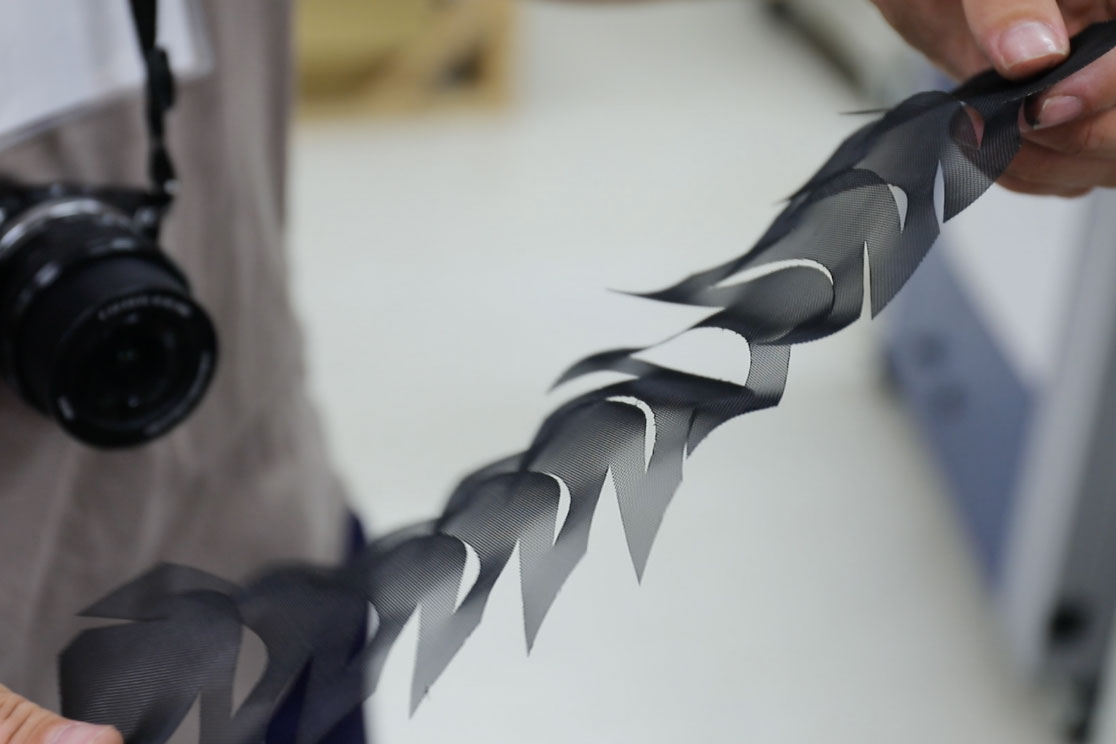
最終プロトタイプの一部
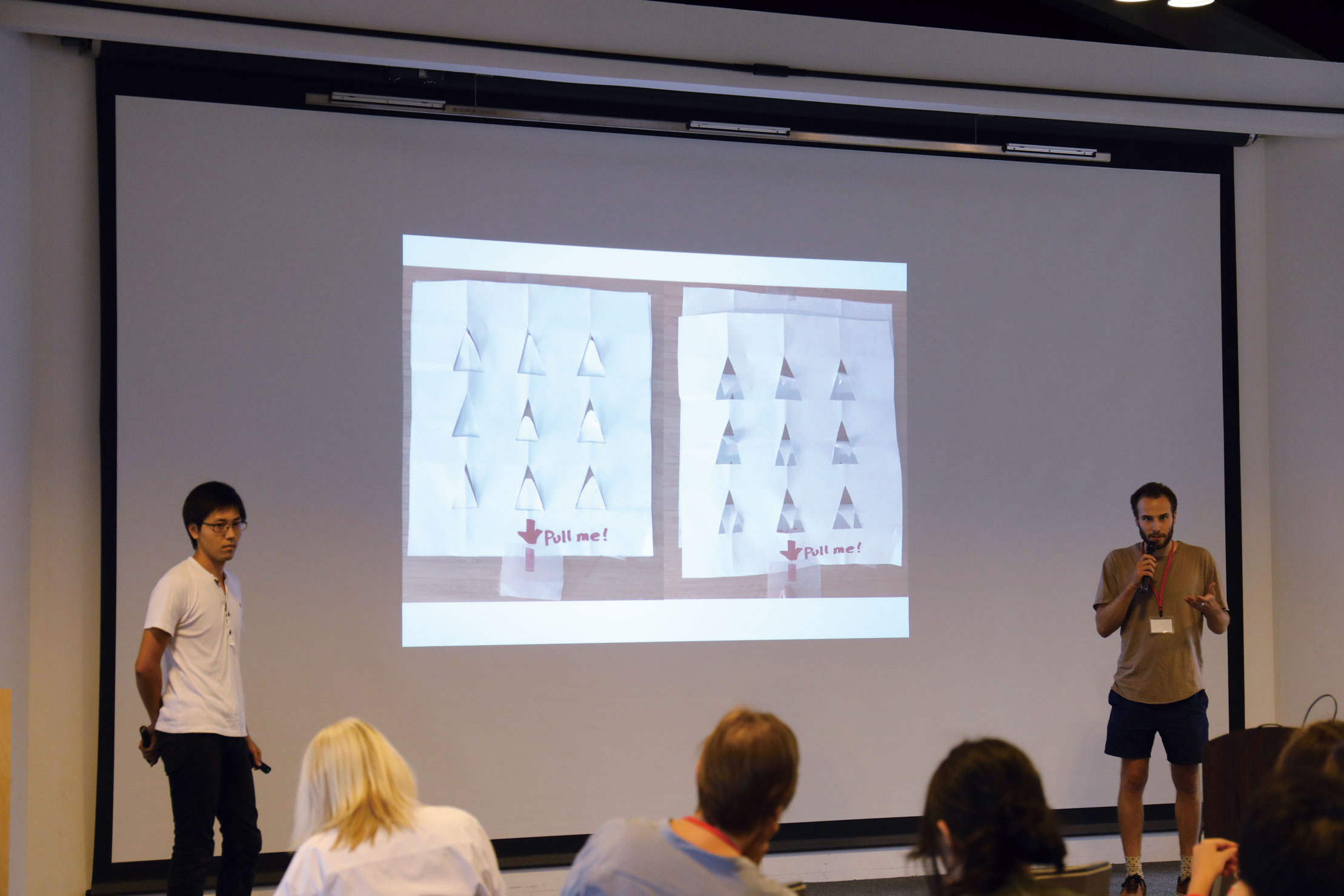
最終プレゼンテーションの様子
テキスタイル・サマースクールという稀有な機会
こうしてレポートを執筆するにあたり、今回のテキスタイル・サマースクールを振り返ってみてその内容の充実ぶりに驚く。
丹後縮緬の技法に注目し、現地に赴いて詳細に素材、組織、表面の関係性を理解しテキスタイルデザインの基本に触れた丹後編。そして広大なテキスタイルの世界を抽象的な切り口から理解し、新しいアイデアを生み出す経験をしたKIT編の即日WS。最後にはデザインクエスチョンを立て、素材に触れながら試作を繰り返し、デザインを出力した成果物発表会。これらがひと連なりとなって、抽象的で捉えにくいテキスタイルデザインへの理解と関心を深める手助けをしてくれた。
そして、テキスタイルデザインは様々な専門分野の人々が協働してこそ、新しい可能性が大いに発見されうるフィールドであるという点も指摘しておきたい。私のチームは5人が5人とも異なる専門分野を持っていたが、新しいテキスタイルのアイデアを創出する際も、それらについてのシナリオを考察する際も、各々が持つ異なる視座からのアプローチが交錯し、思ってもみないようなアイデアに行き着くことができた。
来年度には2回目のサマースクールがおこなわれるとのことなので、私はテキスタイルに興味がある人は分野を問わず参加することを勧めたい。このサマースクールで得られたものは、テキスタイルデザインそのものやその可能性への理解に留まらない、テキスタイルデザインをテーマに様々なデザインアプローチをおこなった経験であり、世界のテキスタイルデザインの学生や生産者、職人の方々、講師陣の方々との貴重なつながりである。それらは即ち、テキスタイルを多層的な原料の構築物として捉え、それを扱いデザインをするための、その地平を拓く冒険的体験である。私はサマースクールを通して得られた知見が、これからの私のデザインや研究テーマにつながっていく可能性を確かに感じることができた。
このような貴重な機会を与えてくれたJulia Cassim教授、Anne Toomey教授、講師陣の方々、D-labの職員の皆様、そしてサマースクールのメンバーの皆に大きな謝意を述べて、このレポートの結びとしたい。
ライター紹介: 野村涼平京都工芸繊維大学大学院建築学専攻。同大学学部在学中に町家研究、建築家吉村順三の住宅研究等を経てドイツ・シュツットガルト工科大に交換留学。主に木造建築のパッシブな環境デザイン手法を研究した。その後デザインシンキングによる製品開発プログラムME310/SUGERや、ノースカロライナ州立大におけるスタートアップサマースクールなどを修了し様々なデザイン領域における思考法を経験。現在はテキスタイルによってもたらされる新たな空間や領域のデザインの可能性を模索している。
Edited by Kouhei Haruguchi
──ニュー・マテリアル・オールド・チャレンジ、オールド・マテリアル・ニュー・チャレンジ
日程|2017年7月24日[月]〜8月4日[金]
場所|京都工芸繊維大学 KYOTO Design Lab、京都工芸繊維大学京丹後キャンパス地域連携センター
コラボレート・パートナー
英国王立芸術学院(RCA)
デザインアカデミー・アイントホーフェン(DAE)
京都嵯峨美術大学
京都府織物・機械金属振興センター

Text: Ryohei Nomura, Graduate School of Architecture, Kyoto Institute of Technology
In August 2016, I took part in the Intelligent Textiles Workshop organised by the KYOTO Design Lab in collaboration with the Royal College of Art (RCA). This turned my attention to textile design. This summer school was a further unique opportunity to collaborate with product design students at the Design Academy Eindhoven (DAE), industrial designers from Portugal and Spain and textile design students at the RCA. From the perspective of an architecture student, I could not help feeling that it was a great opportunity to explore the possibilities of textiles, since not much attention has been paid to them as the materials or components for the spatial design.
Week One – Study Tour to the Tango Peninsula
As a design subject, textiles are full of unknown and known possibilities and are themselves extremely close and familiar to us. In the first half of the summer school, we visited the Tango peninsula to observe how chirimen – a traditional Tango silk crepe product is made and its advanced weaving technology. We encountered surprising findings and inspiration from conversations with producers who are actively developing new technologies and products, despite being faced with a lack of successors and the decline of the industry.
One technique for example, was to weave beautiful sliced abalone shell and thin pieces of wood into the weft; another added entanglement to the warp at regular intervals to give transparency to the textile, and so on. Looking at these techniques that the producers have created with a lot of trial and error, my understanding of textiles was decomposed and reconstructed. That is to say, that a textile is a three-dimensional structure of warp and weft which has the possibility of realizing extremely varied properties and surfaces depending on the combination of the physical properties of the yarn materials, the twisting method and the structure.
The study tour ended with a one-day workshop with the textile producers we had visited. They brought samples of their textiles and worked with us in teams to envisage new scenarios for them.

Tango Study Tour

One-day workshop with the textiles producers
Week Two – Workshop at KYOTO Design Lab
Textile design as consisting soft systems
On the first day of the summer school workshop at KIT, we had lectures on completely different materials pushing the view again from the chirimen and silk fabric that we had focused on during the previous week. These were opportunities to touch on the history and latest products of DuPont’s sustainable synthetic fibers, and on research to create fibers from bamboo, as well as various dyeing techniques such as Japanese traditional Kaki-zome dyeing techniques. Participants focused on various materials and organizations, innovative and traditional ones, and from these gained multilateral and cross-cutting inputs. It was a great feature of this summer school, that we were able to obtain knowledge not only from active producers but also from researchers and people from companies.

Lecture by Dr. Mureo Kaku, DuPont Industrial Biosciences
Michelle Baggerman from DAE and Marion Lean from the RCA, the summer school facilitators, led a one-day workshop to explore the possibilities of textiles in design on the second day. I joined the team with Adams from DAE and Nami Masaki and Rina Aoyama from Kyoto Saga University of the Arts.
Hygiene, Independence and Wellbeing, Social connectivity, and Extreme environments and sports are examples of the keywords proposed for considering new textile concepts. Our team members brought in ideas of textiles referring to those keywords. With reference to those ideas, we figured out the possible materials, organization and surface for realization. The whole team explored the possibilities of each textile as the scenario and then visualized them.
By the way, our team created scenarios called “Hygiene pocket” which uses “textiles that can be cleaned, sterilized and water absorbed once” for the inner fabric of the pocket, and “the textile which has thermal insulation and shock absorbing function inside”. We made a proposal for a wearable Yoga mat with it. Thus, we were able to experience the ideation, its expansion, and expression in a short period. It seemed to be a good starting point for the design process of the final product in the following days.


One-day workshop to explore the possibilities of textiles in design
A public lecture by Anne Toomey, Head of the Textiles Programme at the RCA was held in the afternoon on the second day. She gave an extensive introduction to advanced textile designs developed around the world. In the lecture, textiles that can recycle and recover resources and energy, designs that present concepts of new looms, etc. were featured. What was pointed out here was that textile design is not only about considering the material itself nor designing a product but it is about considering textiles as a soft system to construct them.


Public Lecture by Anne Toomey “Advanced Textiles: Surfaces, Structures and Soft Systems”
Since the summer school ended at 5 pm every day, we went out to dinner with the participants in the evenings. We visited local places such as small bars and the Kamogawa delta and also standard places such as ramen and turning sushi restaurants. From the conversations that happened in such occasions, the interests and thoughts of the individual members became clearer and clearer.

Can textile evoke our sensations, and what will it bring to us?
From the afternoon on the third day, the ideation for the final product finally began. We created four teams, two of them whose aim was to construct a design scenario with a speculative approach, the other two focusing on textiles as “materials” to create products. I formed a team with Adams from DAE and Fu from RCA textiles, Daigo majoring in product design and Waka in textile engineering at Saga University of the Arts, and Chiharu from Kyoto Institute of Technology’s graduate Department of Graphic Design.
In this summer school, it was generally required to quickly create ideas and concepts. I think that it was the biggest challenge for each member to do it in different fields and languages. As I was interpreting for the team, I took the role of team management, it was a hard but valuable experience for me.
We worked that day to establish a design question, to identify what textiles to consider, and make our concept clear. For that purpose, we started by sharing what each member felt was most interesting in the textile design and imagined the topic in our living environment in the distant future. Therefore, we created possible scenarios in the future such as a shortage of fiber raw materials, a decrease of individual occupied space in urban areas, and the expansion of the distribution of bacteria and the insects which mediate them. Especially, we looked at the decline in ability of the human body to experience sensation and its cognition. This was the most interesting topic to the members.
In the presentations on this day, we announced the concept “textile that responds to changes in external environment and specific stimuli, and its surface changes.” From the couches and professors, it was advised to clarify what kind of design question the concept can answer and to create many simple prototypes from the following day to realize the concept. By giving presentations to instructors and facilitators at the end of daily work and having feedbacks quickly, we were able to freely create ideas while clarifying the goal of the team.

Team discussion

From early morning on the fourth day, each team started to prototype in order to realize their concepts. We defined our design question as: “Can textiles evoke our sensations through changes in its surface feeling and what will it bring to us?” First of all, we used handy materials such as paper, cotton, water, etc to try out quickly the possibilities as much as possible. Even with those very simple prototypes, such as a two-layered paper with a prickly surface standing upright when pulled, and a sponge that had protrusions at the bottom so that one can feel them by pushing the sponge strongly, the concept became much clearer and the possibilities were expanded.
It was a pleasant time for the team members to see how lots of ideas and scenarios were backed up by the inputs and discussions so far. In particular, we focused on those two ideas of textiles, the one which has the structure with the honeycomb pattern which is collapsed by friction and compression, and another which has the sharpen protrusions on the surface appeared as stretched. Therefore we examined potential materials to realize them and construction scenarios in which those textiles could be adapted.
Furthermore, the working environment provided by D-lab was very suitable for making things, and it was possible to work on consistent environment from simple prototype to final product while using various softwares and machines like 3D printers, looms and layer cutting machines.


Prototype as textile in which protrusions appear by bending
Last day: Presentation
Our final design scenarios were “textile whose changes of surface feeling help us to perceive and rectify our own wrong everyday postures and movements.” In other words, the internal structure of the textile responds to a specific tension or weight distribution that is generated by a faulty way, for example, by the wrong way of walking or bent standing posture. The textile’s internal structure responds by changing its surface to stimulate us and contribute to recognition and correction of them.
As prototypes, we made the shoes and the T-shirts. In the idea of shoes which rubber plates are cut into the shape of a honeycomb structure with a laser cutting machine and bonded with cloth on which the protrusions are located, users place their weight on specific part of soles with frictional and compressive force from wrong way of walking or standing. Then honeycomb structure in that part collapses and the back of the foot touches the inner protrusions so that the one can tell that his way is damaging his body and can start fixing it themselves. The idea of a T-shirt using a textile combined with a soft cloth, which was cut with a pattern in which a sharp portion is exposed by stretching to the specific direction is combined with a stretchable cloth, when the user’s posture is bent, the sharp portion hits the back and softly prompts posture correction by giving a feeling of discomfort. In addition to these, there were several ideas that did not result in prototyping such as a chair that prevents sitting for a long time and a collar of a T-shirt that encourages hydration in the summer.
The fun of collaborating with people with different expertise and skills was felt by me particularly in that rushing period. Each person positively finds their roles and progresses towards the goal together while communicating closely with each other. I was involved in putting together the presentation while participating in prototype production at the same time.

Production of prototype
In the presentation of the day, each team had to complete designs that were unique and interesting. They used visuals and actual materials a lot in the presentation so that even the first-time people were able to follow the context and understand the design concept easily. Finally, the feedback from Professor Anne Toomey and Professor Julia Cassim for each team was given, and they pointed out that the fact that our team had tried to solve serious health problems brought on by bad posture and wrong walking form with simple materials and methods was valuable.
After the presentation, the audience went to the tables where the prototypes was exhibited. The students, visitors and the gold-decorating craftsmen of Kyoto who lectured in the summer school also came to our table and asked us questions and gave their opinions. It is one of the great significance of participating in this summer school that it is possible to meet people who are interested in these topics, to discuss and to connect and the presentation and the Wrap party were the perfect opportunities for that.

A part of the final prototype

Final presentation
In Conclusion
In writing the report, I looked back on the textile summer school and I am surprised how much content we went through in such a short period.
In the Tango part, we understood techniques by going to the factories and understanding the relationship of material, organization, and surface in detail. In one day at KIT, we acquired the basic knowledge of the vast world of textiles from an abstract perspective and had the experience of creating new ideas. In the end, we set up a design question, carried out iterative prototyping while touching the materials and delivered a design output. These helped us to deepen our understanding and interest in textile design that is abstract and difficult to grasp.
Also, I would like to point out that the textile design is a field where various possibilities can be greatly discovered by people working in various fields of expertise. In my team actually five people had different fields of expertise but when creating ideas for new textiles and considering scenarios about them, each approach from different perspectives interlaced so that we were able to create ideas that I would have not imagined.
Based on these, if this summer school will be held next year as well, I would like to encourage people who are interested in textiles to participate regardless of their fields. Those obtained from this summer school are not limited to understanding textile design itself and its possibilities, but the experience of various design approaches within the theme of textile design. It is a valuable connection with the people, lecturers students, producers of textile, and craftsmen. They were truly adventurous experiences that open up the horizon of textiles design for participants. I am sure that these experiences would definitely help me in my future design and research.
Thank you to Professor Julia Cassim, Anne Toomey, Marie O’Mahony, the facilitators and staff of D-lab and all the members of the summer school who gave us such a valuable experience.
Writter: Ryohei NomuraAn architecture design student in Kyoto Institute of Technology Graduate School. After researching on “Machiya” -old Japanese residence style, and the housing design method of an architect Junzo Yoshimura, went to Hochschule fur Technik in Stuttgart, Germany to study the environmental architecture. I mainly focused on the passive design technologies of wooden buildings. Recently I completed the product development program ME310 / SUGER by design thinking and start-up summer school at North Carolina State University to experience various design domains. Currently I am exploring the possibilities of designing new space and areas brought about by textiles.
Edited by Kouhei Haruguchi
Period: Monday 24 July – Friday 4 August, 2017
Venue: Kyoto Design Lab, Kyoto Institute of Technology (KIT), Matsugasaki, Kyoto + Kyoto Institute of Technology, Kyotango Campus
Collaborating Partners
Royal College of Art (RCA)
Design Academy Eindhoven(DAE)
Kyoto Saga University of the Arts
Kyoto Prefectural Institute for Northern Industry
» Report: KYOTO Design Lab Textiles Summer School – Tango Study Tour